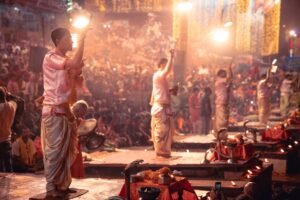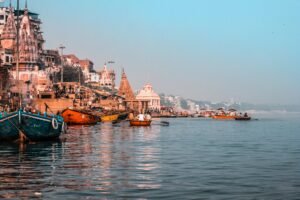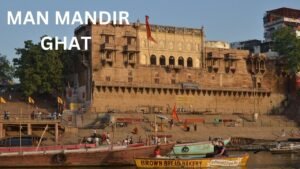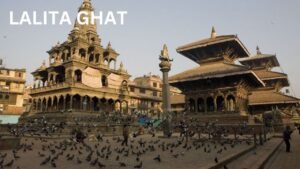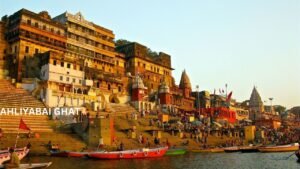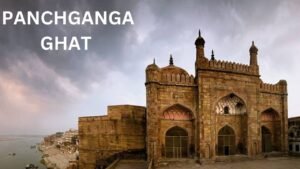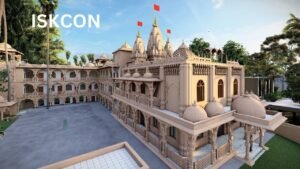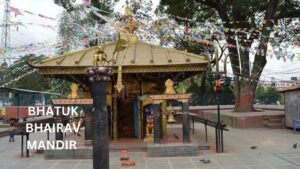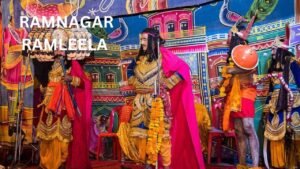Varanasi: Where Spirituality Meets Timeless Tradition
Varanasi, also known as Kashi, is a sacred city located on the banks of the Ganga River. It is a pilgrimage destination for Hindus, who believe that bathing in the Ganges here cleanses the soul. Varanasi, also known as Kashi, is a sacred city located on the banks of the Ganga River. It is a pilgrimage destination for Hindus, who believe that bathing in the Ganges here cleanses the soul.
Best Places To Visit In Varanasi In 2024:
1. Kashi Vishwanath Temple:
The Kashi Vishwanath Temple, located in Varanasi, is a revered Hindu shrine dedicated to Lord Shiva. Renowned for its centuries-old history, the temple underwent reconstruction in 1780 by Rani Ahilyabai Holkar. The sacred Jyotirlinga within is believed to grant spiritual liberation. The temple’s impressive architecture and daily rituals draw devotees and tourists alike. It stands as the spiritual heartbeat of Varanasi, pulsating with the energy of unwavering faith and cultural significance. A visit to the Kashi Vishwanath Temple offers a profound spiritual experience, resonating with the divine essence of India’s cultural heritage.
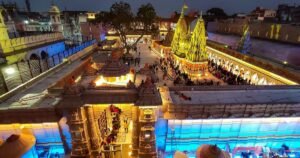
2. Assi Ghat: Tranquility at the Confluence
Assi Ghat, nestled at the merging point of the Assi River and the Ganges in Varanasi, offers a serene escape from the bustling city. Less crowded than some counterparts, this ghat provides a peaceful setting for spiritual activities, yoga, and contemplation. It holds cultural significance, and visitors often come to witness the mesmerizing sunrise or sunset over the sacred Ganges. Assi Ghat invites pilgrims and travelers alike to partake in rituals and soak in the tranquil ambiance that defines the spiritual essence of Varanasi.
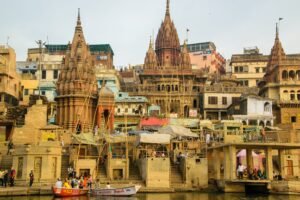
3. Dashashwamedh Ghat: The Spiritual Hub of Varanasi
Dashashwamedh Ghat, the central and oldest ghat in Varanasi, stands as the pulsating heart of spiritual activity. Known for its vibrant and daily Ganga Aarti, the ghat attracts pilgrims, devotees, and tourists alike. The sacred rituals, the bustling market nearby, and the energy of this ancient ghat make it an essential stop for anyone seeking the spiritual essence and cultural richness of Varanasi.
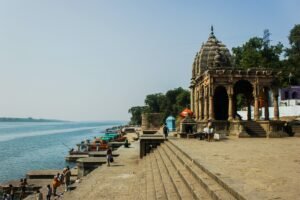
4. Manikarnika Ghat: Sacred Confluence of Life and Death
Manikarnika Ghat, one of the oldest and holiest cremation ghats in Varanasi, holds profound spiritual significance. Located on the banks of the Ganges, it is believed that cremation at Manikarnika leads to liberation (moksha). The perpetual fire symbolizes the eternal cycle of life and death. Pilgrims and visitors experience a poignant reminder of life’s transient nature while absorbing the spiritual energy that permeates this sacred ghat.
5. Sankat Mochan Hanuman Mandir: A Sanctuary of Solace
Sankat Mochan Hanuman Mandir in Varanasi is a revered temple dedicated to Lord Hanuman, the remover of obstacles. Pilgrims flock to this sacred site seeking blessings and relief from troubles. Surrounded by a serene atmosphere, the temple hosts regular prayers and events. The spiritual resonance of Sankat Mochan makes it a haven for devotees seeking solace and divine intervention in their lives.
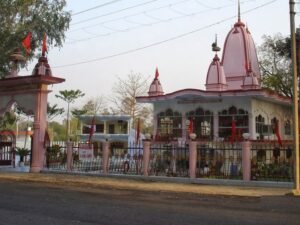
6. Ramnagar Fort: Where History Unfolds
Ramnagar Fort, situated on the eastern bank of the Ganges in Varanasi, is a historical gem narrating tales of regal grandeur. Built in the 18th century, the fort showcases a museum with vintage cars, royal artifacts, and a glimpse into the opulent past of Varanasi’s rulers. The fort, with its architectural splendor, stands as a living testament to the city’s rich cultural heritage and regal history.
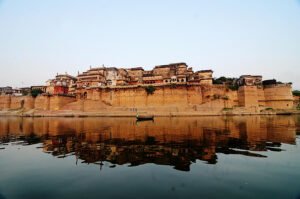
7. Durga Temple: The Vibrant Abode of Goddess Durga
Durga Temple, also known as the Monkey Temple, is a captivating religious site in Varanasi. Dedicated to Goddess Durga, its vibrant red exterior and intricate architecture draw visitors seeking divine blessings. The temple’s serene ambiance contrasts with the lively presence of monkeys around, creating a unique spiritual experience. Devotees come to offer prayers, making the Durga Temple an essential stop for those exploring the spiritual tapestry of Varanasi.
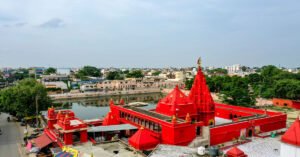
8. Shri Satyanarayan Tulsi Manas Mandir: Serenity in Stone
Shri Satyanarayan Tulsi Manas Mandir in Varanasi is a modern temple dedicated to Lord Rama. Constructed at the spot where Tulsidas is said to have written the epic Ramcharitmanas, its marble walls bear verses from the revered scripture. The temple’s tranquil surroundings and spiritual ambiance make it a peaceful haven for devotees and admirers of literature alike.
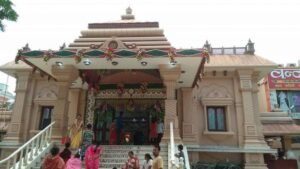
9. Tulsi Ghat: Tranquil Reverence by the Ganges
Tulsi Ghat, a peaceful enclave along the Ganges in Varanasi, resonates with spiritual serenity. Named after the saint-poet Tulsidas, it is celebrated for its calm ambiance. At its heart lies the Tulsi Manas Temple, dedicated to Lord Rama, adorned with verses from Tulsidas’s Ramcharitmanas. Pilgrims and seekers frequent this ghat, finding solace in its quietude, making Tulsi Ghat a cherished spot for contemplation and devotion along the sacred riverbanks of Varanasi.
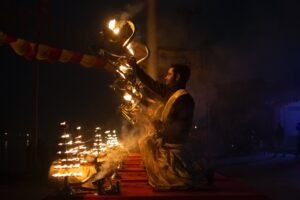
10. Harishchandra Ghat: A Sacred Abode of Eternal Truth
Harishchandra Ghat, nestled along the divine Ganges in Varanasi, stands as a testament to unwavering devotion and eternal truth. Named after the legendary king Harishchandra known for his unyielding commitment to truth, this ghat is a significant cremation ground. Pilgrims and visitors witness the sacred rituals that symbolize the cycle of life and death. The adjacent Harishchandra Temple pays homage to this noble king, creating a spiritual haven where the essence of truth and devotion pervades the air along the timeless riverbanks of Varanasi.

11. Bharat Mata Temple: A Symbolic Tribute to Mother India
Bharat Mata Temple, situated in Varanasi, is a unique shrine that pays homage to the spirit of Mother India. Unlike traditional temples dedicated to deities, this temple is a patriotic tribute, featuring a remarkable marble relief map of undivided India. Devotees and visitors alike gather here to honor the diverse cultural heritage and unity of the nation. The temple stands as a symbolic representation of India’s ethos, fostering a sense of national pride and spiritual reverence.
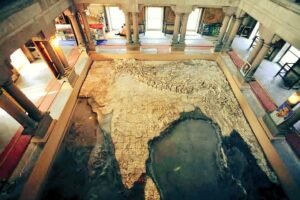
12. Alamgir Mosque (Beni Madhav Ka Darera): A Fusion of Architectural Marvels
Alamgir Mosque, also known as Beni Madhav Ka Darera, stands gracefully near Panchganga Ghat in Varanasi. This mosque is a striking example of architectural fusion, blending Hindu and Mughal styles. Constructed by Aurangzeb in the 17th century, it offers panoramic views of the Ganges. The mosque’s intricate carvings and historical significance make it a captivating site, symbolizing the harmonious coexistence of diverse cultural influences in the spiritual city of Varanasi.
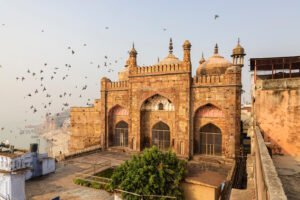
13. Jantar Mantar: Maharaja Jai Singh’s Celestial Playground
Jantar Mantar in Varanasi is a celestial observatory built by Maharaja Jai Singh II, reflecting India’s astronomical prowess. Constructed in the 18th century, it showcases a collection of architectural marvels designed to observe celestial phenomena. The structures include sundials and other instruments that align with the stars. Jantar Mantar is not just an astronomical observatory but a historical testament to India’s scientific advancements, inviting visitors to marvel at the ingenuity of ancient astronomers in decoding the mysteries of the universe.

14. Banaras Art Gallery: A Cultural Canvas in Varanasi
Banaras Art Gallery, located near Assi Ghat in Varanasi, is a vibrant hub for art enthusiasts. Showcasing a diverse collection of contemporary and traditional Indian art, the gallery serves as a platform for local and national artists to display their creations. Visitors can explore a rich tapestry of paintings, sculptures, and artistic expressions, offering a unique perspective on the cultural wealth of Varanasi. This cultural haven adds an artistic dimension to the spiritual and historical charm of the city.

15. Rana Mahal Ghat:
Rana Mahal Ghat is a lesser-known ghat in Varanasi, offering a quieter and more secluded atmosphere compared to the bustling main ghats. It provides a peaceful setting for those seeking a more tranquil experience along the Ganges River.
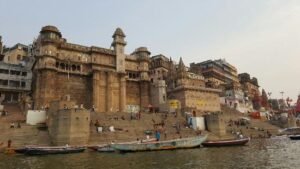
16. Banaras Hindu University (BHU): A Beacon of Knowledge and Culture
Banaras Hindu University, commonly known as BHU, stands as a prestigious institution in Varanasi, Uttar Pradesh. Founded by Pandit Madan Mohan Malaviya in 1916, BHU is a seat of learning that blends tradition with modernity. Spread across a sprawling campus, the university is known for its diverse academic programs, cutting-edge research, and a commitment to promoting Indian culture and values.

17. CHUNAR FORT
Chunar Fort is a historic fort located in the Mirzapur district of Uttar Pradesh, India. It was built by King Sahadeo in 1029 and is situated on a rocky bank of the Ganges River1. The fort has a rich history spanning from 56 BC to the British Raj1. It is located 34 kilometers northwest of Mirzapur and is approached by road from Mirzapur over a distance of 20 miles and along the Ganges River by river craft, a 30 miles journey1. The fort is made of Chunar sandstone and is built in a commanding position, high above a meander in the Ganges River, near the Kaimur Hills1. The fort’s height is 280 feet (85 m) above sea level.

18. GODOWLIA MARKET
Godowlia Market is a bustling local bazaar located in the vicinity of Shri Kashi Vishwanath Temple in Varanasi, Uttar Pradesh, India 1. It is one of the oldest markets in the city and is famous for its silk embroidery, Bhadohi carpets, zari work, wooden carvings, fine silk fabrics, beads, bracelets, shoes, shawls, and jewelry 1. The narrow street is lined with shops and stalls of local vendors selling all kinds of commodities. Frequented by locals who visit the market to purchase groceries, hardware, and household items, this market is also a nice place to acquaint yourself with daily city life and culture .
The market is located at a distance of 5.6 km from Varanasi and is best visited between October and March 1.

19. CHOWK AND VISHWANATH GALI
Chowk and Vishwanath Gali stand out as prominent and bustling streets in Varanasi, Uttar Pradesh, India. Chowk, situated close to the Kashi Vishwanath Temple, is a vibrant market renowned for its diverse street food, sweets, and snacks. It provides an excellent opportunity to immerse oneself in the local culture and culinary delights. Conversely, Vishwanath Gali, tracing its roots back to 1780 when Ahilya Bai of Indore reconstructed the Vishwanath Temple, is among the oldest and busiest streets in Varanasi. Stretching from Gyanvapi Chowk to Dashaswamedh Ghat, it houses the famous Kashi Vishwanath Temple and serves as a popular shopping destination. The street is adorned with shops offering silk sarees, beauty products, ornaments, idols, wooden toys, and regional merchandise. Notably, the temple’s entrance area features shops providing flower offerings and lockers for storing items prohibited within the temple, such as electronic devices.
The historical evolution of Vishwanath Gali can be traced back to the reconstruction of the Vishwanath Temple in 1780 by Ahilya Bai of Indore after its demolition by Aurangzeb. With the temple’s revival, pilgrims began flocking to the area, leading to the establishment of stalls selling various goods and services. This burgeoning market attracted businessmen and affluent individuals from Marwar, Bihar, and South India, who subsequently built guest houses around the temple. This unplanned development gave rise to the serpent-like Vishwanath Gali, symbolizing a serpent around the neck of Shiva, and further solidifying its historical significance.

20. MAN MANDIR OBSERVATORY
Man Mandir Observatory is a historical astronomical observatory located in the Man Mandir Ghat of Varanasi, Uttar Pradesh, India. It is situated on the rooftop of Man Mahal, a palace built by Raja Man Singh of Amber in 1600 AD on the banks of the Ganga River12. The observatory was added to it in around 1737 A.D by Sawai Jai Singh II, the King of Jaipur, who was a great astronomer and the founder of Jaipur city12. The observatory is one of the five existing observatories in India and is famous for its masonry observatory2. Besides inventing a number of instruments, tables, and formulae, Sawai Jai Singh II constructed five masonry observatories located at Delhi, Jaipur, Ujjain, Varanasi, and Mathura. These are popularly known as Jantar Mantar12. The plan of the observatory in the palace of Man Mahal was prepared by Jagannath, an astronomer, and the work was executed by an architect from Jaipur named Sardar Mohan under the supervision of Sadashiva.

21. THE BANARAS SILK EMPORIUM
Is this conversation helpful so far?

